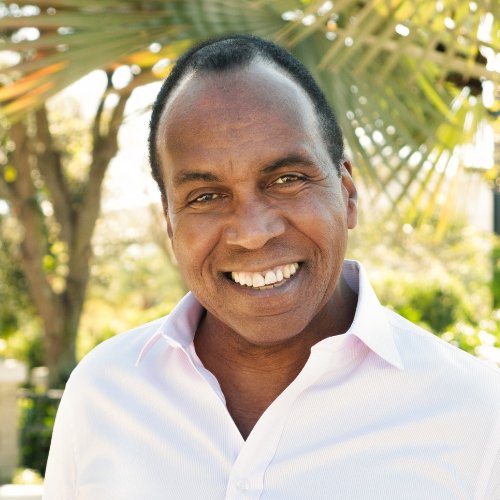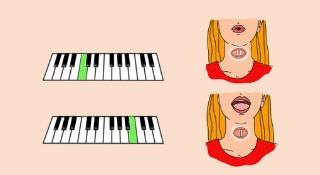How Can I Teach Myself To Sing?
Are you asking the question: how can I teach myself to sing?
If so, you are like me. :)
I was asking the same question a few years ago, and since then I have developed a singing voice that other music lovers compliment me on all the time!
So I’d like to give you a few pieces of advice that will help you discover your singing voice and it’s full potential.
The first tip I’ve got is very important. This tip is to not judge your singing voice prematurely! Many people who want to learn how to sing think to themselves…
“I’m not that talented, therefore I can’t be a very good singer”
This is simply not true. I personally have little singing talent, yet I managed how to sing in a way that makes me sound like a talented singer.
And you know what? Many singers are like this!
So no matter what stage of your singing development you are in at the moment, realize this: You DO have what it takes to develop the singing voice you want.
The key to becoming a great singer is to develop great vocal technique. And this comes down to something even more important. The singing exercises that you practice.
The Secret To Star Singing
Click HERE For The Secret To Star Singing
The Secret To Star Singing
Click HERE For The Secret To Star Singing
You see, unfortunately there are many teachers out there who do not know how to get the best out of your voice.
They may be great singers themselves, but here’s the thing. Great singers usually don’t make great teachers.
It’s the teachers who have struggled themselves but somehow found a way to become a good singer that can teach you the most valuable information.
Take me for example. I used to suck at singing.
And I mean REALLY suck!
My father actually used to say that I sounded like a wounded animal when I sung! I joke about it now, but I used to be VERY discouraged about my voice.
I had all the technical problems you can imagine.
I used to strain to reach my high notes. My voice would become sore and hoarse after a few minutes of singing. My tone quality was terrible!
Yet now I am able to sing with beautiful tone quality, and in a completely effortless way. And I also learned how to expand my vocal range so I can now hit sky scraping notes easily and with great tone.
Here’s the thing that changed my vocal life around. (And it definitely wasn’t talent!)
After asking myself how can I teach myself to sing over and over again, I discovered a highly effective method of learning to sing. A process that actually “forced” my voice to sing with excellent technique.
It sounds strange, but there are certain exercises that can force your voice to operate in a “technically correct” way for singing.
And when you practice these exercises over and over, your voice begins to “drop” the bad habits and begin working the way it was designed to.
So let's go through the seven keys to being able to teach yourself to sing.
We'll start by talking about breathing and singing.
Teach Me How To Sing With Correct Breathing?
If you were to teach yourself singing, one of the first things you’ll come across online is this thing called diaphragmatic breathing.
Now, let me start by saying this: It’s much MUCH simpler than it sounds!
In fact, in the thousands of singers I’ve taught personally over the years, I rarely even address diaphragmatic breathing until we are several lessons in.
But I will address it now, mostly to dispel the myth that it’s hugely complicated.
Simply put, if you can breathe to live then you can breathe to sing!
If you sit and breathe in and out nice and easily for a few minutes, you are experiencing good breathing for singing. The only “bad” breathing habit you may have is if you breath in too shallow.
If you breathe in and feel your stomach collapse inward, then you may be breathing too shallow. If this is the case, simply focus on making sure your stomach expands when breathe in.
Check out this video where I discuss Diaphragmatic breathing in more detail. And for an even more in-depth discussion I created a tutorial that will help.
So can you teach yourself how to sing with proper breath support?
Absolutely!
Concentrate on breathing in nice and deeply and you are in good shape!
Singing on Pitch
When you teach yourself how to sing, one of the best things you can focus on is singing in tune.
If your goal is to impress an audience, singing on pitch is crucial!
The biggest thing an audience will notice is when your voice goes out of tune.
So be learning to hit your notes perfectly, you’ll immediately come across as a more professional, better singer.
Let’s look at some simple ways to begin singing in tune.
The First Step Is To Hear The Notes
When students come to me and say, “teach me to sing”, one of the first thing I’ll do is see how well they are hearing the notes.
If they sound a little pitchy, it means either they are not hearing the notes clearly OR they don’t have the vocal technique to hit the notes on pitch.
Here’s A Trick That Proves You Are Not Tone Deaf!
Often singers will tell me, “I’m tone deaf”. “There is no hope for me!”
This couldn’t be further from the truth! Over and over again I have helped singers begin to hear their notes clearly. Let me give you one of my best tricks to help you train your ears.
Here it is: When you sing a note, focus your hearing to the middle of your forehead.
It may take a little time to get the hang of it, but when you focus on hearing your sound in the middle of your forehead, you’ll be able to clearly hear which note you are singing.
The amazing thing is that once you master this exercise, you’ll be able to focus your hearing on a loud stage and still be able to hear what you are singing!
Another Tip For Self Taught Singing
There is another tip you can use to develop your hearing so you can hit your notes perfectly in tune.
Here’s how it works.
Step 1: Imagine a note that you would like to sing. To do this, I want you to hear the note inside your head. Make it a nice easy one.
Step 2: Now, try to sing this note out loud. See how close you get.
Then go back to Step 1 and repeat the exercise. The more you do it the more accurately you will begin to hit your notes.
That gives you two very effective exercises for singing in tune. Once you get good at these two exercises the audience will begin to respond to your singing because you’ll be hitting your notes right on pitch.
Also, to go into more depth about singing perfectly on pitch, I created an tutorial here that will give you more tips and exercises.
Now lets take a look at the next thing that will help you teach yourself to sing.
Sing In Chest Voice
When teaching yourself how to sing, another important thing to learn is how to sing in chest voice.
Chest voice is the lowest register in your singing range. It has a powerful, thick quality to it.
You will know when you are singing in chest voice because you’ll feel vibrations in your chest area. This is where the term “chest voice” comes from.
Chest voice is usually the vocal register that you use to speak in to. For males it’s easier to sing in chest voice, however females can sometimes find it a little more difficult.
Here’s a video where I discuss chest voice and the best ways to use it:
Can I Teach Myself To Sing In Chest Voice?
To experience your chest voice here’s what to do:
Step 1: To keep things nice and simple, take the song “Happy Birthday”.
Step 2: Find the place in your range where you are singing and you can sense the vibrations in your chest. At the same time you will feel much less of a physical sensation in your head.
When you do this, you are singing in Chest Voice.
IMPORTANT!
The biggest mistake singers make with chest voice is they try and push it too high into their range.
The reason this happens is because they want to get a nice, powerful sound on higher notes.
But pushing “chest voice” up there puts tremendous strain on your voice. So it’s not recommended!
When I was younger and figuring out how to teach myself to sing, I made this mistake and it caused me a lot of problems.
Instead there is a much better way to get that powerful “chest voice” sound in your high notes.
Here’s a tutorial where I show you how.
And also, for a more in depth discussion of chest voice here’s another tutorial.
Now that we've looked at how you can sing the lower notes, let's look at your upper vocal range.
Learn To Sing In Head Voice
An important step in your singing developing is learning to sing with what’s called your “Head Voice”.
Your head voice is a vocal register that covers notes that are higher in your vocal range.
You can tell that you’re singing in head voice because you feel most of the physical sensations of sound in your head.
Head voice is a great thing to develop because it has a really beautiful, sweet tonality to it. It will also help you to hit high notes that will impress your audience!
So how to teach yourself how to sing in head voice?
First, here’s how you can experience your head voice.
Make a high pitched “Oooooo” sound like an owl. This will have you using your head voice. Here’s a video where I demonstrate this for you:
And to get a more in depth education on your head voice, check out this tutorial.
How To Sing Great High Notes
Head voice is certainly a big piece of the puzzle when it comes to singing high notes.
To really understand how to self teach singing though, you need to go a step further.
There is another vocal register you can discover that will give you the best of both worlds from chest voice and head voice.
Teaching Yourself To Sing With A Mixed Voice
When you learn to sing by yourself, there is one thing in particular that will make your voice a cut above.
Get this right, and you’ll be able to sing just about anything you like, with fantastic tonality and balance.
This is really the thing that gives you that slick sound that audiences associate with a professional singer.
Can you guess what I’m talking about?
Well, here it is: You need to learn to develop your “mixed voice”.
What this means is you need to learn to blend your chest voice and head voice together to create a “mix”.
The beauty of being able to mix your chest voice and head voice together is you can create a balanced sound through your entire vocal range.
Down the bottom of your range, you’ll have more chest voice. But blending in a little head voice will give your sound a sweetness to it.
And up the top of your range you will mostly be singing in head voice, but blending in a little chest voice will give your sound power and presence.
Singing your high notes in your mixed voice is what you hear in most Pop and Rock singers. So if you want to know how to learn singing by yourself in those genres, mixed voice is important.
Here’s a video where I show you how to develop this all important “mixed voice”.
How To Train Yourself To Sing With Vibrato
If there’s one thing that will give your voice that extra touch of class, it’s vibrato.
Vibrato is that slick sound you hear singers use when their voice starts to wobble back and forth between two notes.
It’s a quality that says to the audience, “I’m no beginner singer!”.
So learning to sing with vibrato will give your voice a great boost!
Now you may be wondering…
Can You Train Yourself To Sing With Vibrato?
Here’s the truth.
You absolutely can learn to sing with vibrato! And it’s something you should do, because when you have natural vibrato coming through, it’s a sign of good vocal technique.
Let’s talk about how you can get your vibrato going.
How Does Vibrato Happen?
Vibrato is what happens when your vocal chords are able to vibrate in a free and relaxed way. See, when your voice is nice and relaxed, your chords can vibrate in a way where they begin to oscillate back and forth between two notes.
This is where the vibrato comes from.
Now, to get an experience of vibrato if you’ve never been able to do it, you can try to move back and forth between two notes. Start by oscillating between the two notes slowly, and then see if you can speed it up.
This is a way to “force” vibrato to get a feel for it.
Ideally though, you want to develop a much more natural sounding vibrato. So let’s look at an exercise that will help you do this.
Here’s A Exercise You Can Use To Kick Start Your Vibrato
Follow along with the exercise in this video and you’ll be able to begin to get your vibrato going.
Also, for a more in-depth tutorial on vibrato, check out this page.
Sing Any Song You Like
Many years ago when I was teaching myself to sing, I got to the stage where I was able to sing different notes and sound quite good!
At that point it was really time to begin singing songs. And more than that, getting up in front of an audience and performing.
So how do you go about singing songs?
Well, here’s the process I used:
Step 1: Learn the song!
This means memorising both the lyrics and melody.
It can take a little time to learn a song. Repetition is key. Put the lyrics in front of you, then start going over it.
Start with the first verse. Sing through it 10 times with the lyric sheet. Then see if you can do it without the lyrics in front of you.
You’ll probably get most of it, but there might be a few little spots where you forgot. Go back to the lyric sheet and see the lines you need to go over again.
Once you have the first verse down, do the same with the first chorus. Then the second verse and so on.
I usually try to put in a good session on day 1. Then the next day I’ll bring the song up.
Even if I had most of it memorised on the first day, there will be a very patchy spots. I’ll go back to the lyrics sheet and clean them up. After this session on the second day I’ll be getting very close to having the song down.
Step 2: Practice It Over And Over
Once you have the song down, practice will make it better and better.
It’s very simple. There are no real secrets here. Practice makes perfect!
I’ll practice a song anywhere from 5 times to 100 times depending on the difficulty level.
The more you practice the more you’ll get to the place where it becomes automatic.
Step 3: Put Your Own Stamp On It
Once you have learned the song, and practiced it a lot, you’ll be at a place where you can make stylistic choices to spice it up!
This may or may not be necessary. But I really encourage finding ways to put your own spin on it. This will make things really enjoyable for the audience. Because you’ll be giving them something both familiar, but original.
So make it your own!
Step 4: Record Yourself and Listen Back
The best way you can get feedback on how you’re sounding is to record yourself.
When you do this you’ll pick up on easy little changes you can make to keep improving your performance of the song.
In this day and age, it’s easy to record yourself. Just grab your smart phone and make a voice memo or video.
Try it! You’ll be surprised at how much information this will give you.
I’ve followed this exact four step process to learn hundreds of songs. It’s great for self taught singers. Follow it and you’ll be able to sing any song you like!
How can I teach myself to sing?
The answer you’re looking for is a series of exercises that can automatically program correct singing technique into you. Once you do this, you will be able to sing with a large vocal range, have incredible pure vocal tone, and it will all be easy and effortless.
If you’re interested in the vocal lessons that transformed my voice from very poor to very good, you can learn about them here.
If you have asked the question, how can I teach myself to sing? These exercises will give you your best chance at great success!
Good luck!
Return from How Can I teach myself to sing to Become a Singing Master Home
About The Author
 Roger Burnley - Vocal Coach Roger Burnley - Vocal Coach |
Roger Burnley is a vocal coach located in Hollywood, California. He has been teaching singers for over 30 years and singing for even longer than that.
Notable past and present clients include Macy Gray, Brandy, Ray J, The Beastie Boys, James Torme, Taylor Lautner, Nona Gaye, and many more.
His clients have collectively sold more than 30 million albums, with several reaching Platinum and Gold status.
Roger has been featured on VH1, TV Guide Channel, TV One,
and MTV appearing as a vocal expert.
About The Author
 Roger Burnley - Vocal Coach Roger Burnley - Vocal Coach |
Roger Burnley is a vocal coach located in Hollywood, California. He has been teaching singers for over 30 years and singing for even longer than that.
Notable past and present clients include Macy Gray, Brandy, Ray J, The Beastie Boys, James Torme, Taylor Lautner, Nona Gaye, and many more.
His clients have collectively sold more than 30 million albums, with several reaching Platinum and Gold status.
Roger has been featured on VH1, TV Guide Channel, TV One,
and MTV appearing as a vocal expert.









New! Comments
Show me you're alive! Leave a comment below...